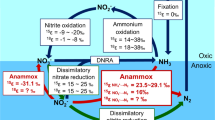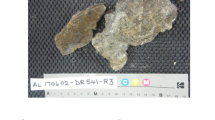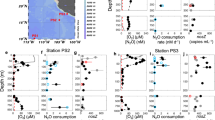Abstract
We performed a suite of 15N incubations (15NO2−, 15NO3− and 15NH4+) with and without the organic-nitrogen (N) compound allylthiourea (ATU), in the suboxic waters of the Arabian Sea. Production of 29N2 in control (-ATU) incubations with either 15NH4++14NO2−, or their analogues, 15NO2−+14NH4+, though small, confirmed the presence of anammox. In contrast, when we added ATU, along with 15NO2− and 14NH4+, there was a much greater production of 29N2, with 92% of the 15N-label being recovered as 29N2 on average. Such stimulated production of 29N2 could not be due to anammox, as the addition of ATU, along with 15NH4++14NO2−, only produced 29N2 equivalent to that in the controls. The ratios of 29N2 to 30N2 produced also precluded stimulation of denitrification. We present this as evidence for a hitherto uncharacterised metabolism potentially capable of oxidising organic-N (e.g. NH2 groups) directly to N2 gas at the expense of NO2−.
Similar content being viewed by others
Main
Much of the surface water across the ocean is near air-saturation with respect to oxygen. In parts of the tropics, however, such as the eastern Pacific (North and South), Arabian Sea and Bay of Bengal, a core of permanently and severely oxygen-deplete (1⩽O2<20μM) water (extending over >300 m on average) can be found between 160 and 1080 m depth (Paulmier and Ruiz-Pino, 2009). Although the cores of these oxygen-minimum zones occupy only ∼0.8% of the total ocean volume, they are responsible for a large amount of the N2 produced (i.e., loss of fixed nitrogen (N)) on Earth (Seitzinger et al., 2006; Codispoti, 2007). Given that the balance between N fixation and its removal through N2 production is key to carbon assimilation by primary production and CO2 modulation in the atmosphere (Falkowski, 1997), the oxygen-minimum zones are vital to the functioning of the biosphere. Evidence supports both denitrification and anammox as being responsible for this N2 production, though discrepancies in the N-budget indicate that this two-path model is incomplete (Dalsgaard et al., 2003; Kuypers et al., 2005; Thamdrup et al., 2006; Ward et al., 2009).
Primarily we visited the oxygen-minimum zones in the central Arabian Sea to measure nitrous oxide (Law and Owens, 1990; Nicholls et al., 2007) and collected water samples from 125 to 295 m at two sites, targeting the characteristic peaks and troughs in nitrite concentration (Codispoti and Christensen, 1985; Morrison et al., 1999; Nicholls et al., 2007). We carried out a suite of 15N incubations with and without the addition of allylthiourea (ATU), an organic-N compound known to inhibit nitrification (Figure 1a and Supplementary Material). Although the role of nitrification in the production of nitrous oxide was minor (Nicholls et al., 2007), the inhibitor measurements themselves provided us with a fortuitous and potentially important finding.
Organic-N and production of 29N2. (a) Molecular formula of ATU showing the primary and secondary amine groups. (b) Production of 29N2 in the presence of 15NO2− plus 14NH4+ with and without ATU (filled and open circles, respectively), and (c) the same as (b), but in this case the 15N-label is on the NH4+ molecule instead of the NO2− (filled and open squares, respectively). We present all of the data from each depth at both sites to show the reproducibility of the response.
The production of N2 via anammox has a unique 1:1 stoichiometry, which provides a very sensitive 15N ‘tool’ to detect anammox in ecosystems, with the stoichiometry proceeding according to (van de Graaf et al., 1995):

The presence of anammox was confirmed at our sites by the production of 29N2 in our control incubations with either inorganic 15NH4++14NO2− or its analogue 15NO2−+14NH4+ (reaction 1). Although the production of 29N2 was low, at less than 70 and 20 nmol 29N2 per litre with either 15NO2− or 15NH4+, respectively, after 96 h (Figures 1b and c), it was roughly equivalent to that previously reported for the Arabian Sea (e.g., ∼18 versus ∼10 nmol l−1 per day; Ward et al., 2009). In contrast, when we added organic ATU along with 15NO2− and 14NH4+, there was a much greater production of 29N2 at all depths at both sites, peaking at 1.42 μmol 29N2 per litre over 96 h, on average (Figure 1b). Indeed, with 15NO2− the turnover of 15N was almost complete and, across all of the incubations, 92% (±3, s.e.m., n=28) of the 15N-label was recovered as 29N2. This production of 29N2 indicated a 1:1 pairing of 15NO2− and 14N, as in anammox (reaction 1). However, here the formation of 29N2 could not be due to the oxidation of NH4+ present in the water, as the addition of ATU, along with labelled 15NH4+ (and 14NO2−), produced 29N2 only in small amounts equivalent to that in the controls (Figure 1c). It could be argued that the measured production of 29N2 was due to a simple organic stimulation of denitrification, for example:

The relative amounts of 28N2, 29N2 and 30N2 in denitrification are governed by a binomial distribution reflecting the frequencies of 15N and 14N in the NO2− pool being reduced, according to:

where p and q are the proportions of 14N and 15N, respectively, in the NO2− pool (p + q is equal to unity) and p2, 2pq, and q2 are the predicted proportions of 28N2, 29N2, and 30N2 produced through denitrification. Accordingly, not more than 50% of the 15N added can ever be recovered as 29N2, the remainder being 30N2. Quite clearly that was not the case as, at all depths at both sites, 29N2 dominated in the ATU-amended samples, with 30N2 contributing far less than that predicted for denitrification (Figure 2).
Predicted and measured 29N2 and 30N2 production. Measured proportions of 29N2 and 30N2 (grey and black bars, respectively) at the maximum enrichment for 15NO2− (∼1.6 μmol l−1) with allylthiourea. The ‘q’ term for each site is the 15N atom (%) of the NO2− pool (below the x axis) at each depth, which gives the ‘chances’ of denitrification producing 30N2 and reflects the mix of ambient 14NO2− (filled circles) and 15NO2− spike. Dashed line indicates the predicted maximum 50% 29N2 contribution from denitrification.
The excess of 29N2 in the ATU-amended samples was not due to denitrification or anammox. Our observations were fortuitous and we did not fully test the nature of the reaction in the field. We have, however, since tested whether or not ATU ‘spontaneously’ breaks down in the presence of the oxidising agents nitrite and ZnCl2 in both oxic and anoxic filter-sterilised seawater in the laboratory. After 2 weeks the ATU remained unchanged (∼79 μM, Supplementary Table S1) and there was no significant production of 29N2 from 15NO2− either with or without ATU (Supplementary Table S2). Thus, ATU appears to be stable in sterile seawater. One reasonable explanation for our observations is, therefore, that the ATU was partially metabolised and one of its amine groups provided the 14N for the production of 29N2 in the incubations with 15NO2−, where the ATU acted as an analogue of urea. Urea is a main component of the complex pool of dissolved organic-N cycling in the ocean (Painter et al., 2008). Some may argue that definitive proof could only be provided by the production of 29N2 after the addition of 15N-labelled dissolved organic nitrogen (DON). However, as 29N2 can only be produced through the one-to-one pairing of 14N and 15N, the production of 29N2 from 14N-DON and 15NO2− is just as equally valid.
Recently, denitrification was reported to dominate the production of N2 gas in the central Arabian Sea, whereas we had previously argued for ‘multiple pathways of N2 production’ that could not be ascribed categorically to either anammox or denitrification (Nicholls et al., 2007; Ward et al., 2009). Here we present evidence for an uncharacterised metabolism, potentially capable of oxidising DON (e.g. NH2 groups) directly to N2 gas with NO2−.
References
Codispoti LA . (2007). An oceanic fixed nitrogen sink exceeding 400 Tg N a−1 vs the concept of homeostasis in the fixed-nitrogen inventory. Biogeosciences 4: 233–253.
Codispoti LA, Christensen JP . (1985). Nitrification, denitrification and nitrous-oxide cycling in the eastern tropical south-Pacific Ocean. Marine Chem 16: 277–300.
Dalsgaard T, Canfield DE, Petersen J, Thamdrup B, Acuna-Gonzalez J . (2003). N-2 production by the anammox reaction in the anoxic water column of Golfo Dulce, Costa Rica. Nature 422: 606–608.
Falkowski PG . (1997). Evolution of the nitrogen cycle and its influence on the biological sequestration of CO2 in the ocean. Nature 387: 272–275.
Kuypers MMM, Lavik G, Woebken D, Schmid M, Fuchs BM, Amann R et al. (2005). Massive nitrogen loss from the Benguela upwelling system through anaerobic ammonium oxidation. Proc Natl Acad Sci USA 102: 6478–6483.
Law CS, Owens NJP . (1990). Significant flux of atmospheric nitrous-oxide from the northwest Indian-Ocean. Nature 346: 826–828.
Morrison JM, Codispoti LA, Smith SL, Wishner K, Flagg C, Gardner WD et al. (1999). The oxygen minimum zone in the Arabian Sea during 1995. Deep-Sea Res Part II 46: 1903–1931.
Nicholls JC, Davies CA, Trimmer M . (2007). High-resolution profiles and nitrogen isotope tracing pairs reveal a dominant source of nitrous oxide and multiple pathways of nitrogen gas formation in the central Arabian Sea. Limnol Oceanogr 52: 156–168.
Painter SC, Sanders R, Waldron HN, Lucas MI, Torres-Valdes S . (2008). Urea distribution and uptake in the Atlantic Ocean between 50 degrees N and 50 degrees S. Marine Ecol Progr Ser 368: 53–63.
Paulmier A, Ruiz-Pino D . (2009). Oxygen minimum zones (OMZs) in the modern ocean. Progr Oceanogr 80: 113–128.
Seitzinger S, Harrison JA, Bohlke JK, Bouwman AF, Lowrance R, Peterson B et al. (2006). Denitrification across landscapes and waterscapes: a synthesis. Ecol Appl 16: 2064–2090.
Thamdrup B, Dalsgaard T, Jensen MM, Ulloa O, Farias L, Escribano R . (2006). Anaerobic ammonium oxidation in the oxygen-deficient waters off northern Chile. Limnol Oceanogr 51: 2145–2156.
van de Graaf AA, Mulder A, Debruijn P, Jetten MSM, Robertson LA, Kuenen JG . (1995). Anaerobic oxidation of ammonium is a biologically mediated process. Appl Environ Microbiol 61: 1246–1251.
Ward BB, Devol AH, Rich JJ, Chang BX, Bulow SE, Naik H et al. (2009). Denitrification as the dominant nitrogen loss process in the Arabian Sea. Nature 461: 78–81.
Acknowledgements
We thank the crew on board the RRS Charles Darwin and CA Davies, JC Nicholls and J Petersen for help with the sampling, experiment and analysis at sea. This research has been supported by a Natural Environment Research Council grant (NER/A/S/2001/01196) to MT.
Author information
Authors and Affiliations
Corresponding author
Additional information
Supplementary Information accompanies the paper on The ISME Journal website
Supplementary information
Rights and permissions
About this article
Cite this article
Trimmer, M., Purdy, K. Evidence for the direct oxidation of organic nitrogen to N2 gas in the Arabian Sea. ISME J 6, 1798–1800 (2012). https://doi.org/10.1038/ismej.2012.18
Received:
Revised:
Accepted:
Published:
Issue Date:
DOI: https://doi.org/10.1038/ismej.2012.18
Keywords
This article is cited by
-
Confirmation of co-denitrification in grazed grassland
Scientific Reports (2015)





